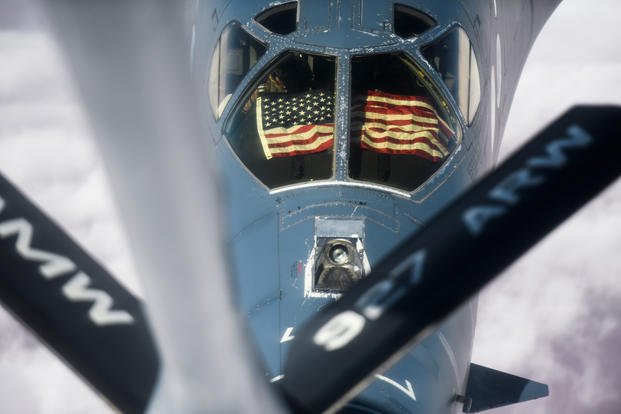The B-1B Lancer bomber, a plane designed with the ability to fly fast and low to the Earth in order to avoid enemy radars, might find itself operating at higher altitudes for the rest of its days in service, as officials weigh options to extend its lifespan.
The move is one of several being considered to keep the aircraft flying for years to come because low-altitude missions increase the wear and tear on the aircraft's structure, Military.com has learned.
"We're closely working with aircrews, maintenance, industry engineers and combatant commands to identify and determine what, if any, changes may be made as we balance operational necessity today with the longevity of the B-1 airframe for the future," said Air Force Global Strike Command spokesman Lt. Col. David Faggard.
Specifically, officials are weighing whether to tell pilots to stop using the B-1's low-altitude terrain-following capability, known as TERFLW mode, during training. The mode is operated by a basic switch on the plane's avionics.
Related: With B-1 Aging and B-21 Still Years Out, Air Force May Soon Have No Go-To Bomber
"The B-1 and our airmen have consistently and professionally provided close-air support in the counterterror fight for decades, a mission the aircraft was never designed to fly," Faggard said. The B-1 was designed for a range of activities, most notably its TERFLW capability, but instead has been used for years in Middle East conflicts -- a role for which it was not designed.
"We're building a viable transition plan to get us from the bomber force we have now to the bomber force of the future. We can change tactics -- altering, bringing back or avoiding any tactics or procedures as necessary on any bomber at any time in the future," Faggard said Friday.
TERFLW, which allows the plane to operate at low altitudes like a jet ski skimming water, was created to allow the B-1 "to sneak in low below enemy radars into Russia during the Cold War, employ nuclear weapons, and get out," said Maj. Charles "Astro" Kilchrist, then-chief of training for the 9th Bomb Squadron at Dyess Air Force Base, Texas, in a 2017 interview.
Kilchrist, also a pilot, showed off the maneuver when Military.com visited the base that year.
Fatigue testing on the bomber has shown that low-altitude training may put additional stress on the airframe, according to two Air Force sources familiar with the discussions. Thus, the argument to limit TERFLW flights in future.
It's not uncommon for bombers to switch up how they fly.
For example, B-52 Stratofortress pilots already tend to avoid low-altitude flights because of the additional stress on the venerable bomber's airframe, according to Alan Williams, the B-52 deputy program element monitor at Global Strike Command. Williams has been involved in the B-52 community since 1975.
"When I first started flying in the B-52, we went down to 300 to 500 feet above the ground," he said in an interview in August. "Two o'clock in the morning, we'd fly over western Wyoming and we'd pop out four hours later over eastern Wyoming. That was hard on the aircraft."
He continued, "Low-level is hard on aircraft. There's a lot of forces -- atmosphere, turbulence, all those things. [But] over the last 30 years, the B-52 has returned to what it was designed to be: a high-altitude bomber."
Officials haven't totally forbidden B-52 crews to fly low, especially if they're testing new weapons, according to a bomber weapons system officer, who asked not to be identified due to not being authorized to speak publicly on the matter.
While the B-52 is sticking around into the 2050s, keeping the B-1 viable until its 2036 sunset date has been a priority for Air Force Global Strike Command.
Gen. Tim Ray, head of the command, announced in September that the Air Force had proved it can modify the Lancer to hold more ordnance -- a step that may pave the way to future hypersonic weapons payloads as the bomber seeks new missions.
In tests with the 419th Flight Test Squadron, teams at Edwards Air Force Base, California, demonstrated how crews could fasten new racks onto the external hardpoints of the B-1, and reconfigure its internal bomb bays to hold heavier weapons.
"The conversation we're having now is how we take that bomb bay [and] put four, potentially eight, large hypersonic weapons on there," Ray said during the annual Air Force Association Air Space and Cyber conference.
"Certainly, the ability to put more JASSM-ER [Joint Air-to-Surface Standoff Missile Extended Range] or LRASM [Long Range Anti-Ship Missile] externally on the hardpoints as we open those up," he said, as reported by Defense News. "There's a lot more we can do."
-- Oriana Pawlyk can be reached at oriana.pawlyk@military.com. Follow her on Twitter at @Oriana0214.
Read More: 3 Dead, 7 Injured After Shooting at Naval Air Station Pensacola; Shooter Killed












